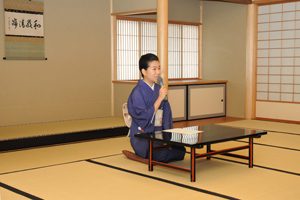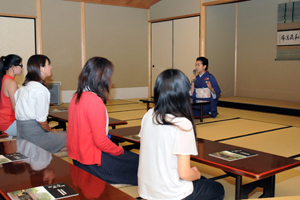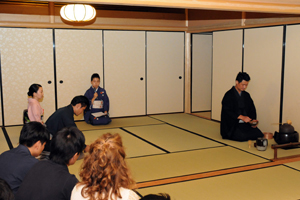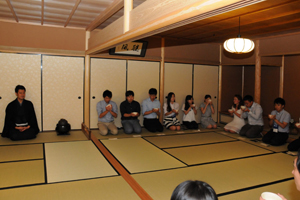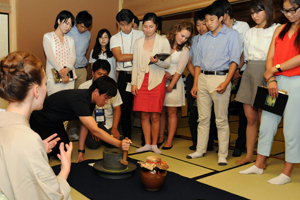On August 15, 2015, thirty-one delegates of the 67th Japan-America Student Conference (JASC) came to Urasenke Konnichian, to learn about Japan's chado tradition. The thirty-one included sixteen students and one JASC alumni from Japan, and fourteen students from America.
The Japan-America Student Conference is a student-organized and student-led exchange program, in which an equal number of university and graduate students from the U.S.A. and Japan are competitively selected each year to spend an intense summer month together, studying and analyzing Japan-U.S.A. relations while visiting diverse regions in the host country. This program was initiated in 1934 by university students concerned by the breakdown of bilateral relations prior to WWII. Since then, it has been held almost every year, except during World War II, alternating its host country between in Japan and the U.S.A. Past conference delegates in 2011 and 2013 also came to Urasenke Konnichian to learn about chado during their time in Kyoto when the host country was Japan.
The 2015 JASC brought together seventy-two students from diverse schools and disciplines. Having spent some days in Hiroshima and Shimane, August 15 was their first day in Kyoto. They split into three groups this day, each of which would experience different elements of traditional Kyoto. The group that came to Urasenke Konnichian was led first to the Heisei Chashitsu’s "Kangetsu-no-ma" room upstairs, for an introductory talk in English (the official conference language) by SEN Makiko, the daughter of Urasenke Iemoto Zabosai, about the history and essence of chado. (top photo)
Following that, they moved downstairs for a demonstration of how a temae (tea-making procedure) for serving usucha (thin tea) to one's guests is carried out. For this, SEN Makiko gave the commentary, while Gyotei (Urasenke Konnichian deputy tea master) YAMAMOTO Sochi performed the temae. Makiko included explanation about the items decorating the alcove, the sweets, the implements, the tea room, and also the traditional kimono attire.
|
